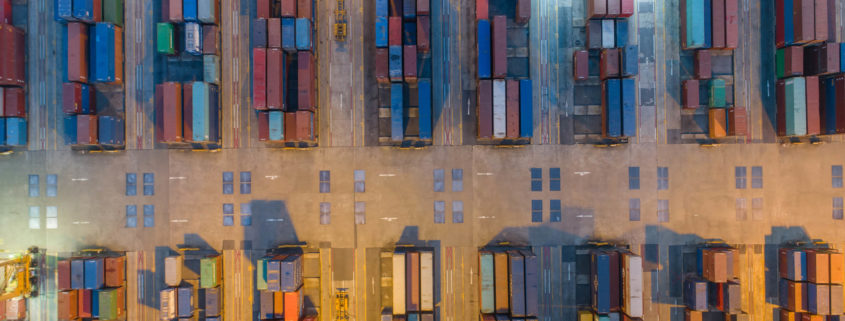Competitive Shipping News
Compiled by Bruce Abbe, SSGA Strategic Adviser for Trade and Transportation
Intermodal container rail service returning to Minot, N.D.
After several years of collaborative effort, intermodal container rail service is set to return to Minot, North Dakota. A unit train of containers is expected to arrive this week at the newly operated facility, formerly North Dakota Port Services, served by BNSF Railway.
North Dakota Governor Doug Burgum announced the intermodal service last week, terming it a “game changer” and saying it will reduce shipping costs for food and farm products by as much as 15%.
“Producers and processors across our state will now have access to competitively priced transportation, which will enable us to further grow and diversify our economy,” Burgum said.
He expressed gratitude for the many individuals and groups who were instrumental in securing the renewed service, including the state’s congressional delegation, private industry, legislators, the North Dakota Trade Office, state departments of commerce, transportation and agriculture, the city of Minot and the Minot Area Development Corporation.
A number of members of the Specialty Soya and Grains Alliance (SSGA) played important behind-the-scenes roles in the public/private team effort to bring intermodal service back to Minot, among them Bob Sinner, president of SB&B Foods of Casselton, N.D., and Vice Chair of the SSGA Board of Directors.
“The long and tedious process to implement intermodal service into and out of Minot has finally come to fruition,” Sinner said. “A ramp operator has been engaged and interested carriers have confirmed their willingness to re-position both 40-foot and 20-foot equipment for North Dakota exporters. The rate matrix and stability of the service is still a bit undefined, meaning it will take some time to get the service issues at a point of comfort for regular and consistent use by customers. We are obviously hopeful and expect that, eventually, the Minot ramp will become a viable option for North Dakota businesses and the future opportunities for the state’s connection to the global market.”
Other key players included Steve Balaski and other officials from the Northwest Seaport Alliance (NWSA), the combined operating company for the ports of Seattle and Tacoma, Wash., that will serve as the ocean export gateways for the BNSF; and Gene Griffin, transportation consultant for the North Dakota Trade Office.
An event is to be held this week, once equipment is in place to accommodate the intermodal service, to announce future plans for the site, including the new operator. North Dakota Port Services previously operated the facility, which leased property from the city of Minot beginning in 2009.
Click here to view the announcement by the North Dakota Governor’s Office; and here to view additional coverage from the Minot Daily News.
Steamship lines set for ‘blowout’ increase in Q3 earnings
The top stories in the global container freight industry media over the past two months have been about the unexpected high demand for imports coming in by containers from Asian manufacturing centers – chiefly in China – to the West Coast. Now that demand, along with the steep hike in import shipping rates, appear set to yield a sharp hike in earnings for the ocean carriers.
Freightwaves news service last week reported on preliminary numbers from Mattson, a smaller container line, that analysts said portends an indicator of “how solid Q3 2020 earnings will be for container lines across the board.”
The rosy profit outlook comes after a sharp cutback in services in the first quarter, including an unprecedented number of cancelled – or “blank” – sailings by ocean carriers trying to manage their capacity during the onset of the coronavirus that shackled operations initially at Asian ports. While demand for some manufactured goods fell, it increased exponentially for key consumer goods products, including personal protection equipment (PPE) manufactured in China and other Asian countries. Combined with restocking needs by retailers and the normal peak season for shipping ahead of the holidays underway, the results have been high demand for container freight shipping on the Trans Pacific for goods imported to the United States. Import shipping rates are at their highest.
So far, export demand remains down and export rates have not risen appreciably. Service, however, is starting to feel the impact as some shippers (including SSGA members) have seen their export containers bumped from scheduled ships at the ports while ocean carriers focus on sending empty containers back to China and key Asian destinations as fast as possible to serve the import demand.
Ocean carriers also have indicated there could be new blank sailings coming again – if not in the fourth quarter, then in the new year – as carriers continue to try to manage capacity through their three main operating alliances.
Ag shippers push to fix persistent ERD problems
Members of the Agriculture Transportation Coalition (AgTC), including the Specialty Soya and Grains Alliance and several SSGA members, are pushing the Federal Maritime Commission and the container ocean line industry to fix persistent problems and unfair penalties due to erratic, changing early return dates (ERDs).
Last week’s SSGA Member News (which goes to the organization’s members only) digital newsletter included a story on the initiative. More information from Freightwaves can be found here.
Containers on the Mississippi?
Perhaps the most ambitious development effort underway to bring new global container shipping service to the inland U.S. is a multi-faceted project spearheaded by American Patriot Holdings (APH).
Last week, Freightwaves featured a story on APH’s initiative, which entails developing a unique, first-of-its-kind, container vessel designed for handling high volumes of containers and fast service on the inland waterways system. Coupled with a new container port at Plaquemines Port Harbor near the mouth of the Mississippi River to better accommodate large ocean-going container ships, the system could become a reality by 2023.







Leave a Reply
Want to join the discussion?Feel free to contribute!